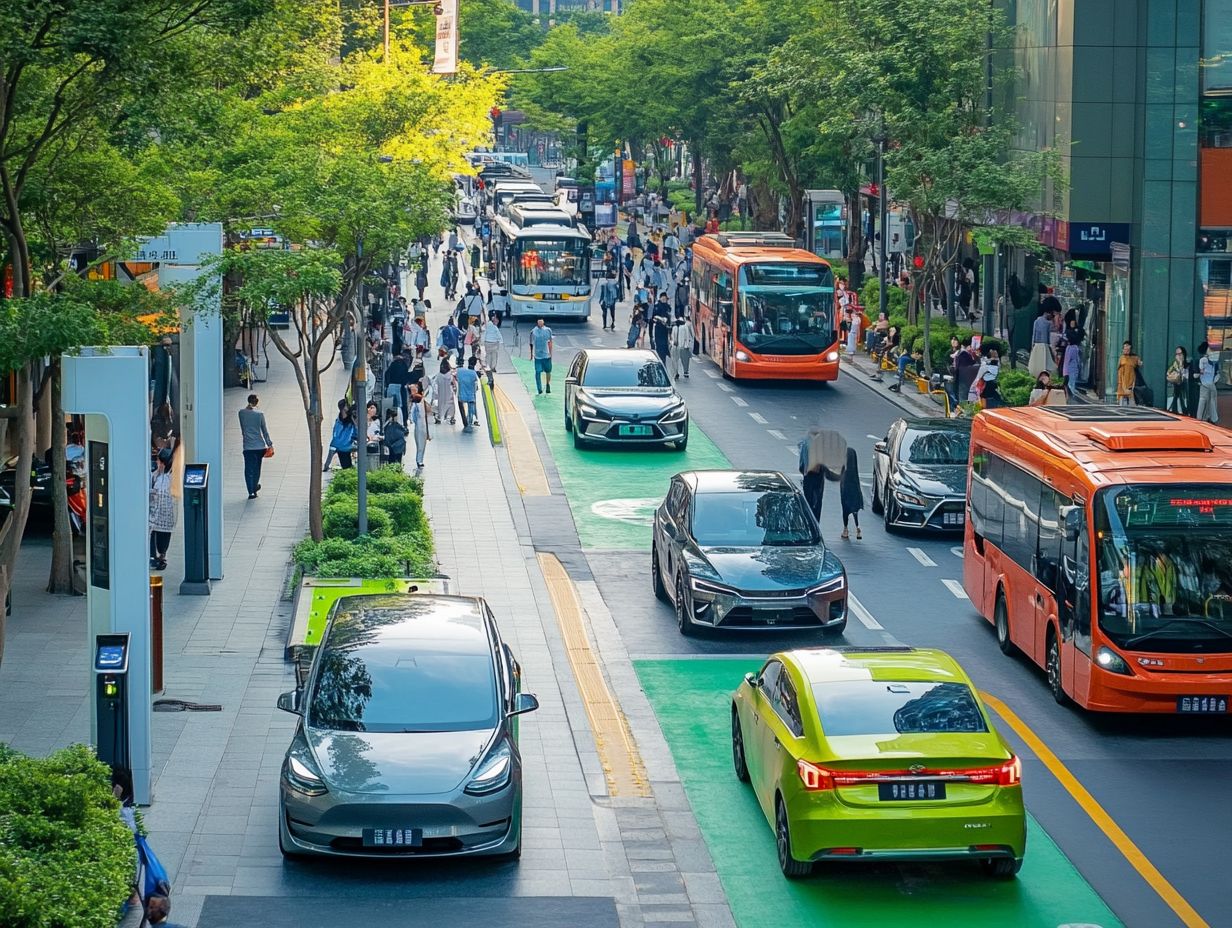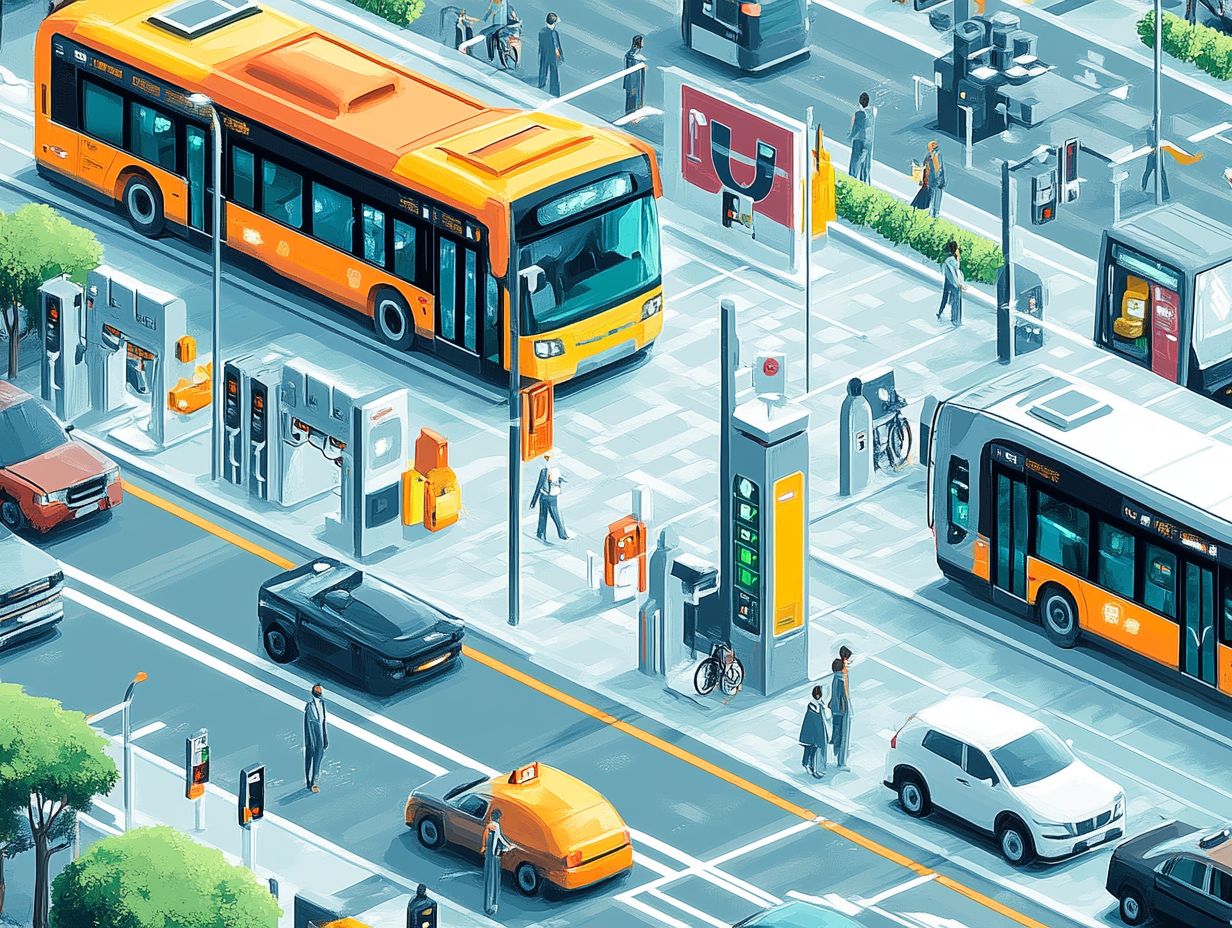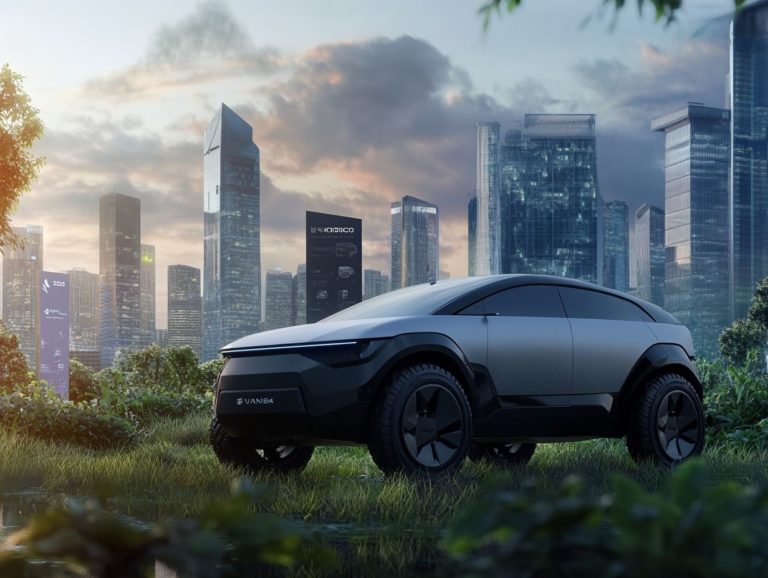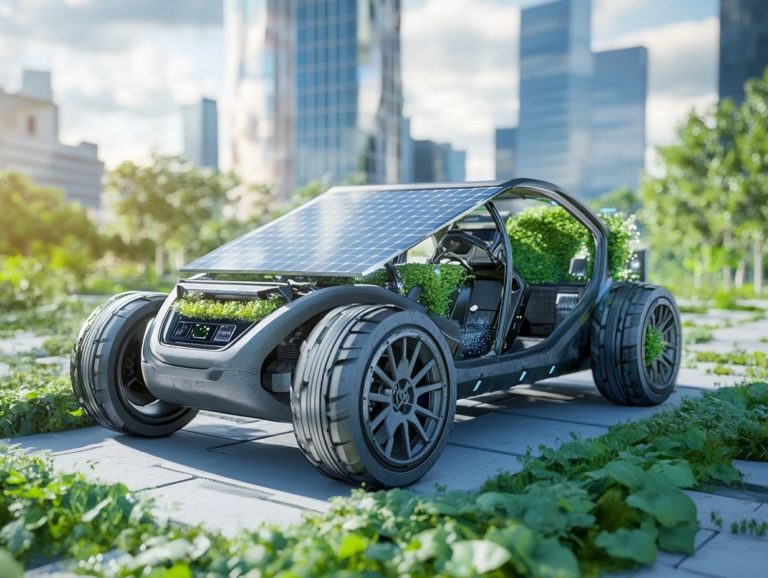the role of electric vehicles in urban mobility
Electric vehicles (EVs) are set to revolutionize urban mobility, providing a cleaner, quieter alternative to traditional transportation.
In a world grappling with pollution and congestion, EVs emerge as a sustainable solution that significantly reduces carbon emissions, improves air quality, and minimizes noise levels. However, transitioning to electric mobility is not without its challenges, such as the need for robust infrastructure and concerns around affordability.
This article delves into the many benefits and hurdles associated with EVs in urban environments, while also spotlighting government initiatives that promote this transition. Join us as you navigate the evolving landscape of electric vehicles and discover their profound impact on our cities.
Contents
- Key Takeaways:
- Benefits of Electric Vehicles for Urban Mobility
- Overcoming Hurdles to Electric Vehicle Adoption!
- Government Initiatives and Support for Electric Vehicles
- Future Possibilities and Impact of Electric Vehicles on Urban Mobility
- Frequently Asked Questions
- What is the role of electric vehicles in urban mobility?
- How do electric vehicles impact urban mobility?
- What are the benefits of using electric vehicles in urban mobility?
- Are there any challenges in implementing electric vehicles in urban areas?
- How can electric vehicles be integrated into urban mobility systems?
- What is the future of electric vehicles in urban mobility?
Key Takeaways:

Electric vehicles can greatly benefit urban mobility by reducing carbon emissions, improving air quality, and decreasing noise pollution. Some challenges and limitations include infrastructure and charging issues, as well as cost and affordability barriers. Government initiatives and policies, such as incentives and support, can significantly promote the adoption of electric vehicles and their impact on urban mobility.
What are Electric Vehicles?
Electric vehicles (EVs) are at the forefront of electric mobility, designed to run without the traditional internal combustion engines we ve known for so long. They play a critical role in driving economic growth and fostering environmental sustainability.
Utilizing cutting-edge battery technology, these vehicles operate on electricity stored in rechargeable batteries, significantly reducing greenhouse gas emissions. The rise in electric vehicles is supported by various public organizations promoting the development of infrastructure, including charging stations and essential technologies that assist both EV drivers and urban communities.
But it s not just passenger cars that fall under the EV umbrella; you ll also find electric buses, trucks, and two-wheelers, all working to reduce our dependence on fossil fuels. Their components like electric motors and braking systems that help recharge the battery while slowing down not only boost efficiency but also deliver a smoother driving experience.
As society pivots toward more sustainable solutions, integrating EV technology into daily routines reshapes transportation and opens the door to cleaner air and lower operational costs for users. This broader movement aims to do more than simply replace traditional vehicles; it seeks to innovate energy systems that contribute to a sustainable future.
Benefits of Electric Vehicles for Urban Mobility
Electric vehicles present a wealth of advantages for urban mobility, significantly enhancing transportation systems within urban communities. They not only foster economic development but also contribute to improved health outcomes for residents.
By integrating electric micromobility options like e-bikes and e-scooters, we can amplify these benefits, making cities more accessible while simultaneously reducing dependence on fossil fuels.
Reducing Carbon Emissions
One of the most significant benefits of electric vehicles is their remarkable ability to drastically reduce greenhouse gas emissions compared to traditional vehicles. This shift contributes to global efforts in the fight against climate change.
By harnessing renewable energy sources, electric vehicles operate with minimal environmental impact, representing sustainable solutions for the future of transportation.
As we draw power from wind, solar, or hydropower, the overall carbon footprint associated with energy production diminishes, enhancing the eco-friendliness of these vehicles. This transition is exciting because it leads to cleaner air quality in urban areas and aligns seamlessly with international climate agreements aimed at reducing carbon emissions.
By integrating EV technology with renewable energy infrastructure think charging stations powered by solar panels we can make significant strides toward a more sustainable future. The implications are profound: a wider adoption of electric vehicles could play a pivotal role in achieving long-term climate goals, leaving a meaningful impact on future generations.
Improving Air Quality
You can breathe easier in urban communities thanks to electric vehicles, which eliminate tailpipe emissions that contribute to air pollution.
This transformation brings substantial health benefits, reducing respiratory issues and elevating your overall quality of life.
As electric vehicles become more prevalent, they not only help create cleaner air but also nurture a sense of community well-being.
The decrease in harmful pollutants can lower healthcare costs, alleviating the economic burden on families and local governments alike.
It also encourages a healthier lifestyle by promoting outdoor activities, as you and your neighbors feel more at ease in cleaner environments.
Urban areas can experience a ripple effect from this improved air quality, which can lead to increased property values and a more vibrant community.
This makes these regions even more appealing for new residents and businesses, fostering growth and vitality in your neighborhood.
Reducing Noise Pollution

Along with the undeniable environmental benefits, electric vehicles play a significant role in reducing noise pollution, creating quieter and more enjoyable living spaces.
The silent operation of electric micromobility options amplifies this advantage, transforming cities into more livable environments.
As these innovative transportation alternatives gain traction, the overall soundscape of urban areas gradually shifts, allowing you to relish a more serene atmosphere.
With less background noise from traditional combustion engines, your everyday activities whether it’s engaging in conversations, enjoying outdoor dining, or participating in community events can thrive without interruption.
This reduction in noise pollution enhances your mental health and well-being, nurturing a stronger sense of community, as people feel more inclined to engage in social interactions.
The move toward electric micromobility paves the way for a sustainable future where cities can prioritize green spaces and pedestrian-friendly environments, ultimately elevating the quality of urban life.
Overcoming Hurdles to Electric Vehicle Adoption!
Electric vehicles offer amazing benefits, but several challenges hold us back from fully embracing them in our cities!
Among the key issues are the need for robust charging infrastructure and concerns regarding the cost and affordability of electric vehicles.
These factors can significantly influence workforce development and access for potential EV drivers, creating hurdles that must be addressed to fully embrace the electric revolution.
Infrastructure and Charging Challenges
A significant barrier to adopting electric vehicles is the insufficient charging infrastructure, which is crucial for supporting EV drivers in urban environments.
Public organizations play an essential role in tackling this challenge, working tirelessly to expand the availability and convenience of charging stations to promote electric mobility.
As the number of EV drivers continues to rise, your need for reliable access to charging points becomes increasingly urgent.
In urban landscapes, where charging demands are most pronounced, inadequate facilities can lead to the fear of running out of battery power for potential electric vehicle owners.
Public organizations are pivotal not only in increasing the number of charging stations but also in ensuring they are strategically located in high-traffic areas and easily accessible.
Collaborations between these organizations and the private sector can yield innovative solutions, ultimately transforming urban infrastructure to be more EV-friendly and facilitating a smoother transition to a sustainable future.
Cost and Affordability
The cost and affordability of electric vehicles may weigh on your mind. The initial purchase price often surpasses that of traditional vehicles, which can limit economic growth in urban communities.
However, financial incentives and support from government initiatives can ease some of these concerns. When analyzing the overall cost dynamics, consider not just the upfront expenses but also ongoing costs like maintenance and fuel savings.
Many electric vehicle owners find that although they face a higher initial investment, lower energy costs and reduced maintenance requirements lead to significant savings over time. Programs designed to increase accessibility and incentivize adoption are vital.
These programs make it more financially feasible for you as an individual buyer and help stimulate community growth by promoting cleaner technologies and sustainable practices.
Government Initiatives and Support for Electric Vehicles
Government initiatives play a crucial role in advancing the electric vehicle landscape. Programs such as the Biden Administration’s policies and the 2022 Inflation Reduction Act offer essential support for infrastructure development and consumer incentives.
The Department of Energy, alongside Clean Cities initiatives, shows strong commitment to fostering sustainable transportation solutions. Engaging with these programs benefits you and contributes to a broader movement toward a greener future.
Incentives and Policies

Incentives and policies presented by federal and state governments play a fundamental role in promoting electric vehicle adoption, offering exciting financial perks that make going electric even more appealing! This includes tax credits and rebates managed by agencies like the Internal Revenue Service.
Supported by research from reputable organizations such as the National Renewable Energy Laboratory, these initiatives aim to cultivate a more sustainable transportation sector. For example, the federal tax credit rewards you with a substantial reduction in your income tax when purchasing an electric vehicle. This credit can be up to $7,500, depending on the vehicle’s battery capacity.
Many states also implement their own incentives, including additional rebates that can further lower the purchase price. Local governments and utility companies often get involved too, offering discounts on the installation of charging stations to encourage your transition.
Together, these efforts create a compelling financial argument, making electric vehicles an attractive option for a wider audience.
Future Possibilities and Impact of Electric Vehicles on Urban Mobility
The future of electric vehicles is on the brink of an exciting transformation for urban mobility. Innovations in battery technology and technology that allows electric cars to send energy back to the power grid are setting the stage for seamless integration into urban communities.
These advancements will significantly influence economic growth and bolster sustainability initiatives within the transportation sector, creating a more efficient and environmentally friendly future.
Predictions and Potential Changes
Predictions for the future of electric vehicles suggest a transformative impact on urban mobility, with notable improvements in economic development and infrastructure integration ahead. As more consumers like you embrace electric mobility, the transportation sector is set for substantial shifts toward sustainability.
This evolution enhances the ecological footprint of cities and creates fertile ground for community growth. As cities adapt to the rise of electric vehicles, expect a growing demand for charging stations and smart grids, necessitating innovative infrastructure upgrades.
Urban planners and policymakers will rethink zoning laws and public transport systems, paving the way for a more integrated approach to mobility. Future advancements could lead to increased job opportunities in tech and renewable energy sectors, stimulating local economies and benefiting you directly.
Watch this video to learn more about the exciting future of electric vehicles and their impact on urban living!
Frequently Asked Questions
What is the role of electric vehicles in urban mobility?
Electric vehicles are vital for sustainable urban mobility. They reduce carbon emissions and promote cleaner air in cities.
How do electric vehicles impact urban mobility?

Electric vehicles can ease traffic congestion in cities. They are more cost-effective and can fit well into public transportation systems.
What are the benefits of using electric vehicles in urban mobility?
Electric vehicles are not only environmentally friendly but also have lower maintenance costs. They generate less noise and last longer than traditional vehicles.
They reduce reliance on fossil fuels and support energy independence.
Are there any challenges in implementing electric vehicles in urban areas?
A major challenge is the lack of infrastructure, like charging stations, which can slow down the adoption of electric vehicles.
People are also concerned about the initial cost of buying an electric vehicle.
How can electric vehicles be integrated into urban mobility systems?
Electric vehicles can fit into urban systems through car-sharing and ride-sharing services. They can enhance public transport with dedicated lanes and parking spots.
City planners can encourage electric vehicle use with tax breaks and subsidies.
What is the future of electric vehicles in urban mobility?
The future of electric vehicles looks bright as cities aim for sustainability. With technological advancements, they are set to become a common mode of transport.
Electric vehicles will help create cleaner and greener cities.






